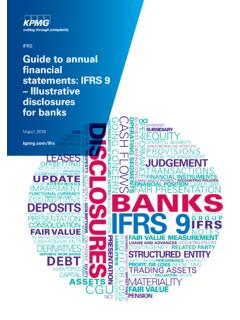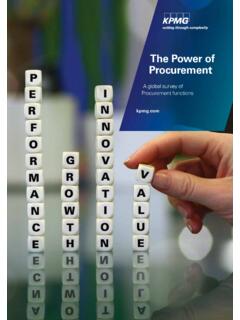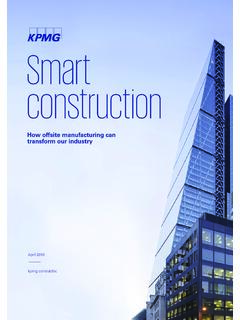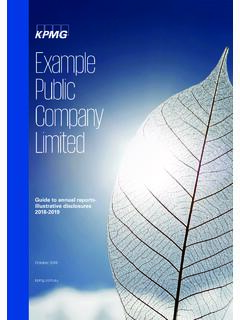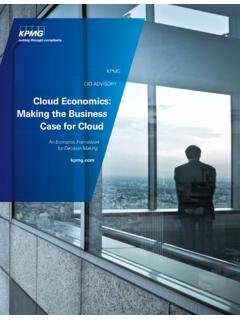Transcription of Fund Transfer Pricing - assets.kpmg
1 fund Transfer PricingKPMG BeogradFinancial Services Team2016 FTP2 2016 KPMG Beograd, a Serbian limited liability company and a member firm of the KPMG network of independent member firms affiliated with KPMG International Cooperative ( KPMG International ), a Swiss entity. All rights reservedContentsIntroduction to IFRS 9 3 The Journey 4 Why now? 5 Case study 6 Why KPMG? 7 Our approach 9 KPMG gCLAS 10 Would you like to see more and further than others in terms of your profitability?3 2016 KPMG Beograd, a Serbian limited liability company and a member firm of the KPMG network of independent member firms affiliated with KPMG International Cooperative ( KPMG International ), a Swiss entity.
2 All rights reservedContents PageIntroduction to fund Transfer Pricing (FTP) [4] What is FTP? [4] Internal Transfer and ALM risks centralization [5]Main targets of FTP [6]Potential consequences of not having FTP [7]Exemplary scope of work, timeline and modules [9]AppendicesWhy KPMG? [11]4 2016 KPMG Beograd, a Serbian limited liability company and a member firm of the KPMG network of independent member firms affiliated with KPMG International Cooperative ( KPMG International ), a Swiss entity.
3 All rights reserved- The FTP system groups together the financial risks generated by commercial transactions with in a Central Finance Unit (CFU). CFU is generally managed by the ALM/Treasury department, which has the necessary expertise and resources to assess and hedge the financial This centralization of risks is done thanks to a system of internal transfers between the commercial (business) lines and the CFU. These internal transfers are made via the theoretical purchase of customer deposits from deposit centers and the theoretical sale of funds to loan centers.
4 The Pricing terms of such transfers constitute to fund Transfer Pricing (FTP)Banks have realized the need for an effective Transfer Pricing system in order to manage funding, the balance sheet structure (financial or ALM risks), and risk adjusted into account decreasing market rates environment and the fact that majority of Banks NBI comes from Net interest income, the FTP system is : National Bank of : Annualized Banking Income of Serbian Q3banking sector2015 Net interest income 73%Net fee and commission income 19%Net income from fin. transactions 5%Other income 3%Total 100%What is FTP?
5 - fund Transfer Pricing (FTP) is a well known practice in finance. It is a part of the overall management information, accounting and control system which includes: Pricing , bud-geting and profit planning, ex-post profitabil-ity measurement (profit ability controlling) and It is a widely used and comprehensive tool in overall financial management. Some would say it s crucial for effective and efficient not only financial but banking business FTP system serves as main tool for expost profitability measurement, profitabili-ty follow-up and controling per various axis (business units, products, branches, relation-ship managers etc.)
6 5 2016 KPMG Beograd, a Serbian limited liability company and a member firm of the KPMG network of independent member firms affiliated with KPMG International Cooperative ( KPMG International ), a Swiss entity. All rights reservedIntroduction to fund Transfer Pricing (FTP)Internal (theoretical) fund Transfer and ALM risk centralization could be presented as followsFigure 2 ALM risks cantralizationManagement BoardALCOALML iquidity portfolio incomeLiquidity mismatchInterest rate mismatchFunding costReference rateReference rateLiquidity premiumLiquidity premiumOtherOtherInterest rate gapLiquidity gapFX gap$ FTP rateFTP rateRiskRiskAssetsLiabilitiesMarketMarke tFigure 1 Theoretical internal transfersALM centerFTPFTPD epositsProcess of commercial products internal pricingCommercial loansNotional investments / Replacement yield for
7 DepositsCommercial margin on loans calculated on the basis of FTPs cost of fundsCommercial margin on deposits calculated on the basis of FTPs replacement ratesNotional funding / Cost of funds for loansCommercial depositsFunding6 2016 KPMG Beograd, a Serbian limited liability company and a member fi rm of the KPMG network of independent member fi rms affi liated with KPMG International Cooperative ( KPMG International ), a Swiss entity. All rights reservedStrategicgoals of FTP T o defi ne funding cost for the assets and to calculateNIM for asset items To defi ne reinvestmentyield for the liabilities andto calculate NIM for liabilityitems To stabilize NIM for allcommercial deals bytransferring (isolating)interest rate, liquidity andFX risk from BUs to CFU To defi ne Pricing benchmarkfor clients deals (pricingtool)
8 And thus ex-anteprofi tability measurement To establish effi cient ex-postprofi tability measurementper various axis and thusto link budgeting andcontrolling activities To impact BUs salesstrategy through conceptof incentives (subsidies) viaManagement FTP To signalize a real, existingmarket conditions in termsof market prices of sourcesand alternative placements,and thus infl uencecommercial lines to fi netune the prices of theirproducts FTP should align risk-takinginitiatives of BUs withliquidity and interest raterisk exposure they create forthe whole Bank BUs take risk they cancontrol and manage BUs are responsible forclients Pricing Fair assessment ofeconomic performance ofevery BU.
9 Commercialmargin then becomes thesole result of negotiationsby BU with customers Business people shallunderstand how theprofi tability is measuredand shall be motivated byprofi tability indicators FTP requires reliable ITsystem and support FTP requires comprehensiveFTP Policy and MethodologyIntegration of FTP into general Bank s management systemWhat are main targets of FTP?FTP changes the overall commercial mindset of the Bank Regulations on liquidity: Minimum liquidityrequirements from local regulator or from Basel III in form of NSFR and LCR requirement Recommendations on Organizing Effective Liquidity Management BCBS requirements FSA requirements Best practicesRegulatory requreiments and best practice7 2016 KPMG Beograd, a Serbian limited liability company and a member fi rm of the KPMG network of independent member fi rms affi liated with KPMG International Cooperative ( KPMG International ), a Swiss entity.
10 All rights reservedWhat are potential consequences of not following/having FTP?How we can helpConsequences of not having FTP systemVolatile result of BUs due to not transferred and not hedged liquidity and IR riskWithout FTP top management is not able to distinguish profi table BUs, segments, products, branches, front offi cers etc. from non-profi table onesBUs are unclear on real margin of their products. Non-market based FTP overstates performance of some BUs and understates that of others and leads to unfair and ineffi cient performance-rewards decisionOverstated profi tability of non-funded products creates wrong incentives for BUs to disproportionally grow portfolioTotal level of liquidity and IR risk cannot be measured and managed.



